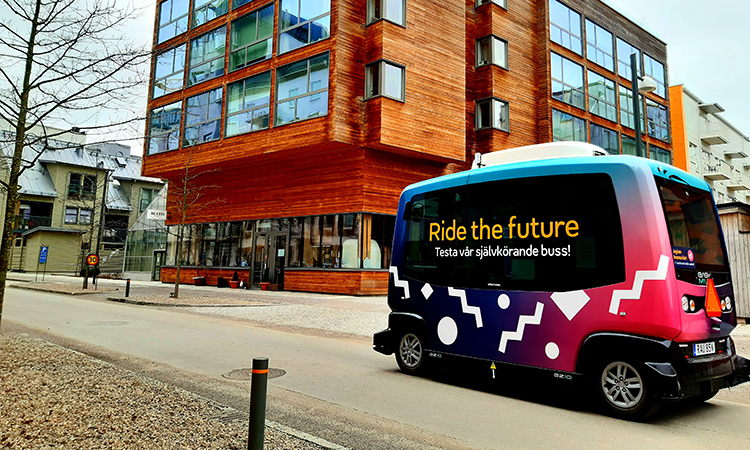
How can autonomous vehicles contribute to sustainable mobility planning?
SHOW is the flagship pan-European initiative that is piloting autonomous vehicles (AVs) and working to define a tipping point in AV development timelines to make them a reality of tomorrow. Building upon the 13 relevant use cases identified in the former SPACE project, it is focused on concretising the formula for the feasible and efficient integration of AVs in the public transport network, while quantifying their contribution to the objectives of sustainable mobility planning.
Cities are focusing on developing a more liveable environment, implementing the visions and goals stated in their Sustainable Urban Mobility Plans (SUMPs), but are struggling to understand the potential impacts of novel mobility solutions combined with policy actions.
In this context, the deployment of autonomous vehicles (AVs) can be either an opportunity or a threat to achieving such goals, depending on the approach defined. The evidence, so far, suggests that the impact of AVs – by either reproducing the privately-owned car, or delivering service schemes competing with established public transport – will lead to a strong increase in vehicle kilometres travelled (VKT). The first scenario would clearly lead to more car traffic, whereas the second may bring better mobility (fewer parked cars, improved access to public transport) but less efficiency overall (smaller vehicles replacing buses, trains and less active mobility).
However, if transport authorities take a proactive role to operate AV fleets cooperatively by integrating with their public transport network and other sustainable solutions, there is a strong opportunity to reach desired outcomes. This third scenario would enhance the public transport network with AVs and shared mobility services of different sizes, potentially enabling the opportunity to transport every citizen to their destination with up to 80 per cent fewer cars1.
As a result, this scenario represents a promising alternative to car ownership: (i) it offers seamless door-to-door mobility (for people and freight) that is both comfortable and convenient through a combination of services; (ii) provides the service at lower operational costs (driverless); (iii) improves energy efficiency and air quality (fewer cars, more fleet electrification); (iv) enhances accessibility to key services for less mobile persons; and (v) improves safety due to fewer human errors (related to 90 per cent of road accidents), contributing to ‘Vision Zero’. Thus resulting in more accessible, healthier, greener, more inclusive and safer cities, as well as in suburban and rural areas.
SPACE: Paving the way for AV deployment
Aiming to coordinate the proactive efforts of different operators and authorities worldwide, in 2018, the International Association of Public Transport (UITP) launched the SPACE project (Shared Personalised Automated Connected vEhicles)2 – a global initiative to contribute to placing public transportation at the centre of the AV revolution and building a combined transport ecosystem.
An important focus of this multi-stakeholder initiative, involving 50 international entities, was on tailoring AVs to different specific realities where they could add value. AVs provide many opportunities for better urban mobility services, but how they can best be integrated depends on the characteristics of the area. Under this premise, the SPACE partners defined the first list of 13 relevant use cases for integrated AVs to be deployed in environments with different densities, targeting different users3, as presented in the table below.
Cities are focusing on developing a more liveable environment, implementing the visions and goals stated in their Sustainable Urban Mobility Plans (SUMPs), but are struggling to understand the potential impacts of novel mobility solutions combined with policy actions.
In this context, the deployment of autonomous vehicles (AVs) can be either an opportunity or a threat to achieving such goals, depending on the approach defined. The evidence, so far, suggests that the impact of AVs – by either reproducing the privately-owned car, or delivering service schemes competing with established public transport – will lead to a strong increase in vehicle kilometres travelled (VKT). The first scenario would clearly lead to more car traffic, whereas the second may bring better mobility (fewer parked cars, improved access to public transport) but less efficiency overall (smaller vehicles replacing buses, trains and less active mobility).
However, if transport authorities take a proactive role to operate AV fleets cooperatively by integrating with their public transport network and other sustainable solutions, there is a strong opportunity to reach desired outcomes. This third scenario would enhance the public transport network with AVs and shared mobility services of different sizes, potentially enabling the opportunity to transport every citizen to their destination with up to 80 per cent fewer cars1.
As a result, this scenario represents a promising alternative to car ownership: (i) it offers seamless door-to-door mobility (for people and freight) that is both comfortable and convenient through a combination of services; (ii) provides the service at lower operational costs (driverless); (iii) improves energy efficiency and air quality (fewer cars, more fleet electrification); (iv) enhances accessibility to key services for less mobile persons; and (v) improves safety due to fewer human errors (related to 90 per cent of road accidents), contributing to ‘Vision Zero’. Thus resulting in more accessible, healthier, greener, more inclusive and safer cities, as well as in suburban and rural areas.
SPACE: Paving the way for AV deployment
Aiming to coordinate the proactive efforts of different operators and authorities worldwide, in 2018, the International Association of Public Transport (UITP) launched the SPACE project (Shared Personalised Automated Connected vEhicles)2 – a global initiative to contribute to placing public transportation at the centre of the AV revolution and building a combined transport ecosystem.
An important focus of this multi-stakeholder initiative, involving 50 international entities, was on tailoring AVs to different specific realities where they could add value. AVs provide many opportunities for better urban mobility services, but how they can best be integrated depends on the characteristics of the area. Under this premise, the SPACE partners defined the first list of 13 relevant use cases for integrated AVs to be deployed in environments with different densities, targeting different users3, as presented in the table below.
www.intelligenttransport.com



